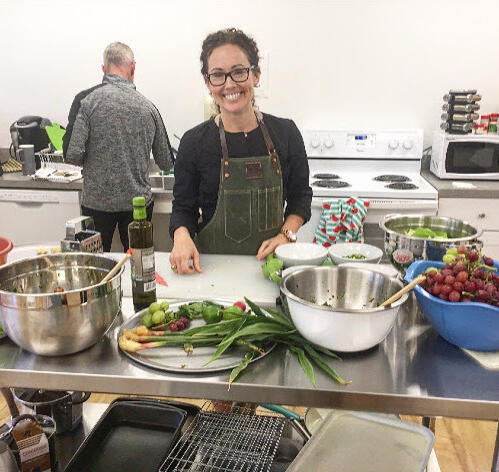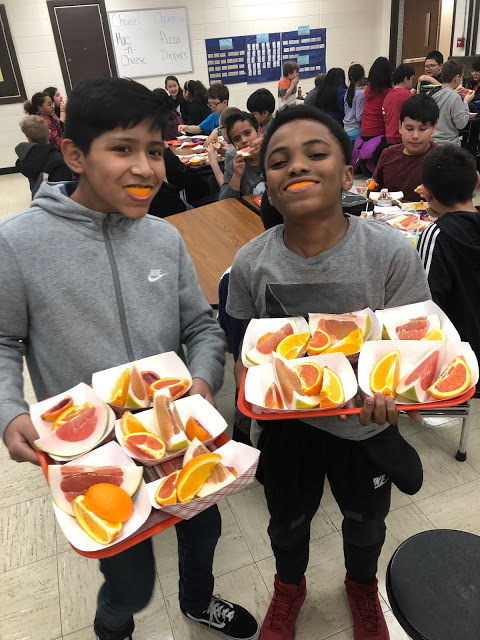
One Parent's Journey Towards Better School Food
January 15, 2020 | By Lindsey Shifley
As a concerned parent and community member, I’ve worked with my school district to bring fresh food and nutrition education to our students since 2012. I am proud to be a Chef Ann Foundation Parent Advocate for real school food. But why did I become a parent advocate in the first place?
Why & How
I dove into the unknown waters of school food after a family food change deeply impacted the course of my daughter’s learning, attention, and social development. I became passionate about getting more real, whole, and nutrient-dense food into the school lunchroom; I knew that if one child could go from failing to thriving in less than 5 months, then connecting others to the positive message of good food education could make a real difference.


Why & How
I dove into the unknown waters of school food after a family food change deeply impacted the course of my daughter’s learning, attention, and social development. I became passionate about getting more real, whole, and nutrient-dense food into the school lunchroom; I knew that if one child could go from failing to thriving in less than 5 months, then connecting others to the positive message of good food education could make a real difference.
Schools are the biggest restaurants in our communities, and these “restaurants” directly impact our students’ mind-body/gut-brain connections. We all care about how well our children are learning, but we don’t necessarily focus on how nutrient-dense foods can unlock a student’s mind and support increased emotional wellbeing.
The WHY is easy. The HOW is hard.
- HOW can one make change as a parent advocate?
- HOW can one help get more real school food into the lunchroom?
- HOW can one help move the needle from “I don’t eat school food” to “I love school food”?
Here is how the Chef Ann Foundation can help you spark more school food love in your district.
Make It Work
In 2013, I reached out to my school district, Diamond Lake District 76, and became a member of the D76 Wellness Committee. (If a Wellness Committee does not exist for your school district, can you inspire one to form or to meet more regularly? Our group was “paper official” at the time, but not meeting regularly.)
I made connections with staff members and began building trust with those who shared the same passion for improving school food. Together with a school nurse, we applied for the Chef Ann Foundation Project Produce grant in 2015, and were awarded the grant for the 2016 school year. We named our pilot program the “Chef’s Tasting Table” (CTT) to bring more fresh produce into the lunchroom once a month.
To this day, it continues to be a huge success. Here’s how our CTT program works in a nutshell, and how you can implement something similar in your district:
- Plan the tasting with a member of your school staff or administration. It is as simple as a citrus tasting to making a smoothie or a dip to pair with cut produce. The hardest part is planning for large quantities of food, especially if you have never done this before.
- Coordinate with your district’s food service department. They may be able to assist with ordering food for sampling, food preparation, handing out samples or any equipment needs. Just be aware that they have busy schedules and might not be able to add to their already heavy workload! No matter what, it’s good to keep them in the loop and they may have the capacity to get more involved in the future.
- Choose seasonal produce and be creative - what new produce can you share with students in the lunchroom? Start with one tasting and go from there. (Can’t get into the lunchroom? Start with a tasting at a school event to gather momentum and support. Learn and keep growing.)
- Coordinate with the school lunchroom staff and set up a table in the lunchroom for produce prep. Make sure you have access to electricity for a high powered blender or food processor if necessary.
- Gather a few parent volunteers. Having a team of 2-3 is wonderful, but I have done many events alone now that I have gotten the hang of it.
- Don’t forget to use disposable gloves or any other items necessary to follow food safety guidelines.
- Once the students have gone through the lunch line and have begun eating, I take a few minutes to talk to the students about the tasting with some fun food education facts.
- I serve each table with help from the other teachers/lunch monitors/volunteers. This saves time and allows the kids to focus on eating, not standing in another line (we had a separate line the first year and it limited eating time). Trays and platters are a must to get lots of tastings out at once.
- Consider a tasting successful if 30% love it, 30% don’t, and 30% think it’s just ok. This is how you know you are stretching the students’ food education experience. It’s ok if kids don’t like it—they tried something new and this is a SUCCESS.
- Provide a recipe (if applicable) to the students and staff so that they can make it at home and spread the food love. Connect the dots!
Our CTT Program has been so successful that the administration has funded the program every year since 2016. Moreover, starting this year, the Board of Education and administration made the HUGE decision to partner with a neighboring school district, whose “from scratch” central kitchen (run by Quest Foods) now serves our entire district.* It’s been a great way to quickly make the transition to serving healthy, fresh meals until we are ready to become a self-operated scratch cook meal program ourselves. And the students are eating it up: our National School Lunch participation is up by nearly 20%, which means we are most certainly providing more real school food for all!
Key Takeaways
So, what have we learned? We are still learning! And… Small steps work. Here are some of my most important takeaways from being a parent advocate in my district.
- School lunchroom culture can change. Volunteer your time when it’s feasible for you.
- Positive and enthusiastic school lunch staff make a big difference in getting kids to try new things, especially older students.
- Knowledge is power—pursue and digest the growing body of research and data that supports better nutrition for better health, real food, learning, and emotional development.
- Patience, perseverance, and creativity is required because this work is new. Model love for good food, and an adventurous spirit for trying new things.


Key Takeaways
So, what have we learned? We are still learning! And… Small steps work. Here are some of my most important takeaways from being a parent advocate in my district.
- School lunchroom culture can change. Volunteer your time when it’s feasible for you.
- Positive and enthusiastic school lunch staff make a big difference in getting kids to try new things, especially older students.
- Knowledge is power—pursue and digest the growing body of research and data that supports better nutrition for better health, real food, learning, and emotional development.
- Patience, perseverance, and creativity is required because this work is new. Model love for good food, and an adventurous spirit for trying new things.
There are few examples of how to make changes towards more real food in our American school lunchrooms. The Chef Ann Foundation is leading the way with all sorts of resources to help parent advocates and school administrations create their unique map towards more real school food. Anyone can help make change in a school district and CAF is here to help parent advocates every step of the way. Check out their incredible grant offerings, school food training program, and most especially their awesome Parent Advocacy Toolkit.
As parents, we are an essential source of inspiration to help get food education back into our schools. Stick with it. There is no one better than us to spark new school food ideas for our districts. We will continue to experience the challenges and thrills of laying foundations for others to join us in building. Keep it fun. Keep it positive, for this energy is what fuels others to join us. Ride the waves of success and disappointment. Let the negatives go when they come at you. Begin again. Stay grateful. It’s worth it.
Become a CAF parent advocate with me and join this incredible real school food movement!
*Editor’s note: The Chef Ann Foundation advocates for a self-operated cook-from-scratch program whenever possible, though partnering with a neighboring district is a great way to incorporate scratch-cooked food depending on your district’s options and capabilities.
Lindsey Shifley is a certified Mind Body Eating Coach and Wellness Chef for Compass Hiking and Yoga, a softball pitching coach & food educator in Lake County, Illinois, and a former Super Food Ambassador for Jamie Oliver’s Food Revolution, which closed its programming in 2018. Check out her blog, The Mullies, here.
Lindsey Shifley
Lindsey Shifley is a certified Mind Body Eating Coach and Wellness Chef for Compass Hiking and Yoga, a softball pitching coach & food educator in Lake County, Illinois, and a former Super Food Ambassador for Jamie Oliver’s Food Revolution, which closed its programming in 2018. Check out her blog, The Mullies, here.






